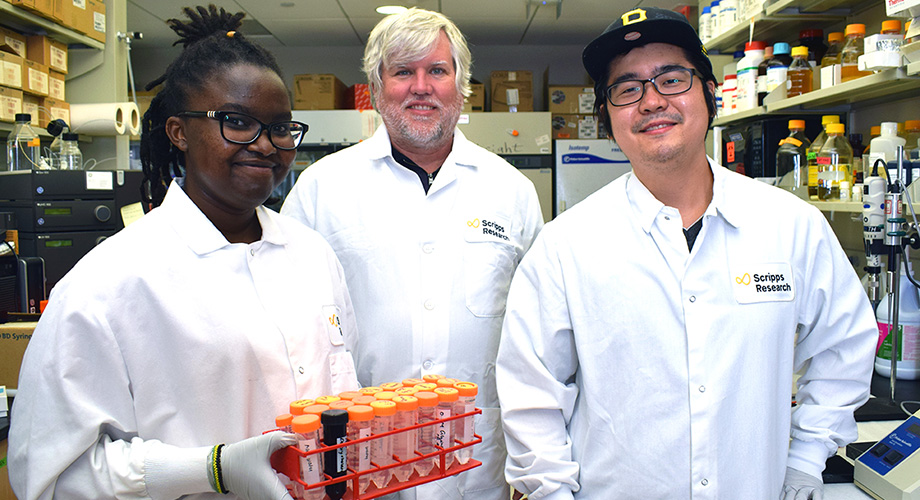
Kendall Nettles, PhD, (center) meets with two students in his lab, Jacqline Njeri (left) and Charles Min (right). Nettles and colleagues designed drug-like molecules that appear to fight estrogen-sensitive breast cancer in two ways, in cell studies. Njeri and Min are co-authors on the paper, published August 27, 2021, in PNAS.
Dual-action breast cancer compounds overcome common drug-resistance issues
By distorting estrogen receptor shape in two different ways, compounds offer a two-for-one punch to estrogen-sensitive cancer cells.
August 30, 2021
JUPITER, FL—A set of compounds developed by scientists at Scripps Research in Florida target estrogen-sensitive breast cancer cells in new ways, potentially creating better options for patients with treatment-resistant cancers.
“Hormone therapies for breast cancer have been one of the greatest success stories of molecularly targeted medicines. But a significant fraction of patients don’t respond to these therapies,” says Kendall Nettles, PhD, associate professor of Integrative Structural and Computational Biology, and lead author on the study published Friday afternoon in the journal Proceedings of the National Academy of Sciences.
“There’s a continued unmet medical need for better hormone therapies. This represents the first change in approach in 20 years,” Nettles says.
Drugs like tamoxifen, fulvestrant or anastrozole are frequently prescribed for estrogen-sensitive breast cancers. But over time, some breast cancers can develop resistance, through inflammatory processes identified by Nettles’ group and others in 2017, and through expression of resistance genes including EGFR.
The compounds developed by Nettles and colleagues work by interfering with estrogen’s ability to activate its cellular receptor in the traditional way, as seen with the hormone therapy tamoxifen, but also by a second inhibitory mechanism. Tests in cells showed greater efficacy in the presence of drug-resistance mechanisms, Nettles says.
Estrogen and cancer: Going Up
Seven out of 10 breast cancers are sensitive to estrogen. The hormone promotes cancer growth by activating receptors on the cell surface which respond a bit like an elevator’s up button. When touched, they send chemical signals into the cell nucleus that lead key growth and proliferation genes to march into action.
That’s why doctors treat estrogen-sensitive cancers by either suppressing estrogen production or interfering with estrogen’s ability to bind those receptors. If the cell can’t receive the signal, the estrogen won’t activate more tumor growth. However, shutting off all of estrogen’s activity brings menopause-related side effects including osteoporosis and hot flashes.
Depending on a breast cancer patient’s age, and whether that patient is a woman who has passed menopause, doctors will prescribe either a group of medicines called selective estrogen receptor modulators (SERMs), such as tamoxifen, or ones called selective estrogen receptor down-regulators (SERDs) such as fulvestrant, Nettles says.
At a molecular, structural level, those drugs interact with the pocket where estrogen binds and use a single, carefully positioned side chain to block the receptor’s growth promoting activity.
Structural studies drive design
Working with colleagues from Scripps Research and the University of Illinois at Urbana-Champaign, Nettles’ team designed the set of compounds to interfere with estrogen binding, via distortion of the estrogen receptor binding pocket, and via binding with two different molecular side chains.
Their studies showed the compounds acted either as estrogen receptor down-regulators, or, much like tamoxifen, as selective estrogen receptor modulators. Their two different side chains can be altered in a variety of ways to influence potency and manage side-effects, Nettles says.
Chemist John Katzenellenbogen, PhD, built the molecules in Illinois, while in Florida, at Scripps Research, Tina Izard, PhD, oversaw x-ray crystallography studies that revealed the molecules’ structure, and Pat Griffin, PhD, oversaw hydrogen-deuterium mass spectrometry studies that enabled studies of the compounds’ effect on estrogen receptors. Those studies showed the compounds destabilized or repositioned the receptor shape, allowing for a different method of direct binding.
One-third of women with early-stage breast cancer treated with tamoxifen developed resistance to the drug within two to five years, a recent study found. The new compounds are urgently needed, Nettles says.
Next steps include testing the compounds in mouse models of breast cancer, and tweaking the molecules to enhance their drug-like properties, such as staying in the bloodstream for the appropriate length of time. Most investigational drugs fail endpoints before reaching the clinic, but Nettles is optimistic about the compounds’ path forward.
“We’re hopeful this could be a breakthrough for treatment-resistant breast cancer,” Nettles says. “With a new mechanism of action, the compounds do what you could expect from combining two different drugs, but in one molecule.”
In addition to Nettles, Izard, Griffin and John Katzenellenbogen, authors of the study, “Dual mechanism estrogen receptor inhibitors,” are co-first authors Jian Min of Hubei University in China and the University of Illinois at Urbana-Champaign; and Jerome Nwachukwu of Scripps Research. Other authors include Valeria Sanabria Guillen, Yvonne Ziegler, Shunchao Yan, Kathryn Carlson, Yingwei Hou, Benita S. Katzenellenbogen, and Sung Hoon Kim of the University of Illinois at Urbana-Champaign; plus Sathish Srinivasan, Erumbi Rangarajan, Scott Novick and Charles Nettles of Scripps Research Florida, Bruce D. Pascal of Omics Informatics in Honolulu, HI, and Rene Houtman of Precision Medicine Lab in The Netherlands.
Support for the research came from the National Institutes of Health, the Breast Cancer Research Foundation, Shengjing Hospital of China Medical University, and Frenchman’s Creek Women for Scripps Research.
For more information, contact press@scripps.edu

